Are you a Quiet Speculation member?
If not, now is a perfect time to join up! Our powerful tools, breaking-news analysis, and exclusive Discord channel will make sure you stay up to date and ahead of the curve.
New aggro decks in Modern tend to be streamlined synergy machines full of critters. But "goodstuff"-style creature decks à la Jund, which wield Modern's known best cards, do slip through occasionally. Perhaps the best-known example of this phenomenon is Traverse Shadow, a deck that blew Modernites away when it first reared its head over a year ago. But recently, I've noticed a steady influx of novel, spell-based aggro decks 5-0ing Competitive Leagues online. Even more surprising, many of these decks lean blue.
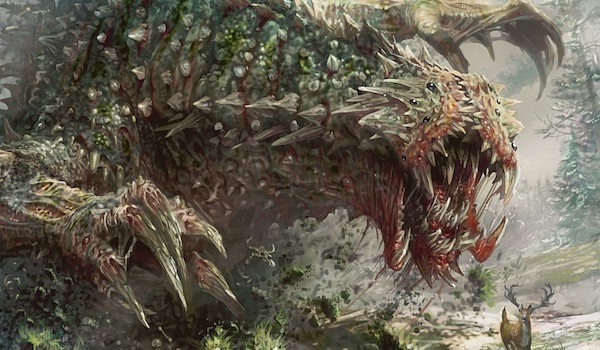
Today, we'll take a close look at some of the Temur decks we've seen crop up lately: Temur Midrange, Eternal Command, and a particularly maddening make of Temur Delver. At the end of the week, we'll look at the Jeskai decks.
Turning Temur
My longstanding love of Goyf, Bolt, cantrips, and permission, coupled with my track record on Temur Delver, have led some players to peg me as a Temur aficionado. Truth be told, the wedge doesn't do all that much for me besides happen to house my favorite cards; Temur trends a tad reactive for my tastes. I also believed the wedge too reactive for Modern's demanding metagame parameters. Still, Temur decks aren't complete strangers to success in the format, and lately have been putting up results.
 Temur's main hurdles in Modern are:
Temur's main hurdles in Modern are:
- Its reactiveness. Tarmogoyf just doesn't produce pressure like it used to. In some matchups, sure, but Fatal Push now exists to throw a wrench in this gameplan. And relative to what Modern's other decks are doing nowadays, hitting a few times with Goyf is a far cry from "aggressive."
- Its inability to remove large creatures. Anything with 4 or more toughness is a challenge for Temur to trump reliably. Black has Fatal Push; white has Path to Exile; Temur has a wealth of way-worse options available.
I'd argue that the wedge still struggles with these issues today. So how have the recently successful Temur lists addressed them?
Fairest of Them All
Temur Midrange, by THE_GUNSLINGERS (5-0)
We'll start with the most generic-looking Temur Midrange list possible, courtesy of Todd Stevens. Temur Midrange has its devout followers, and this deck looks to me like it would fulfill just about all of their needs. Cantrips? Check. Utility creatures? Check. Reach? Check. Cryptic Command? Check!
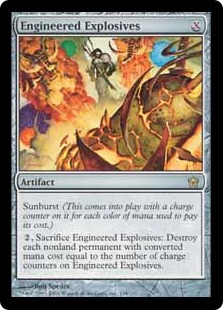 I think Todd's big innovation here is mainboarding 3 Engineered Explosives. Temur has always struggled to kill creatures with more than three toughness, as outside of Lightning Bolt, its viable removal spells are limited to say the least. Here, Explosives plays that role against low-cost creatures specifically. Hollow One and Tasigur? We won't be killing those. But Tarmogoyf, Scavenging Ooze, and Death's Shadow just became much more manageable.
I think Todd's big innovation here is mainboarding 3 Engineered Explosives. Temur has always struggled to kill creatures with more than three toughness, as outside of Lightning Bolt, its viable removal spells are limited to say the least. Here, Explosives plays that role against low-cost creatures specifically. Hollow One and Tasigur? We won't be killing those. But Tarmogoyf, Scavenging Ooze, and Death's Shadow just became much more manageable.
Related are Explosives's abilities as a utility card. It doesn't have to remove a creature, unlike lackluster options such as Roast or Harvest Pyre; Explosives can take out artifacts and enchantments, planeswalkers, and even 20 Goblins tokens against Storm. David's piece on the latest artifact combo deck, "The Hidden Strength of Krark-Clan Ironworks," examines the card's many abilities in detail, further speaking to the sunburst card's relevance in Modern.
Eternal Devotion (Remix)
Eternal Command, by TEAM5C (5-0)
Eternal Command is a deck first seen in the hands of Souta Yasooka, who took the Vial-featuring spell deck to Top 4 at the 2012 Players Championship. Return to Ravnica, with its Deathrite Shamans and Abrupt Decays, spelled doom for Eternal Command as they did for many blue-based tempo shells of that era. This showing is the first I've seen from the deck in years.
 Some things have changed since Command's glory days: Scavenging Ooze has entered the format, and makes an appearance here. So does Huntmaster of the Fells. Most game-changing of all, though, is Opt, the unassuming cantrip that's all but taken over Modern blue decks. Swapping Serum Visions for Opt lets Eternal Command play at instant-speed more often, taking pressure of its mana and increasing synergy with Aether Vial. I imagine the switch is particularly helpful against reactive control decks like UW.
Some things have changed since Command's glory days: Scavenging Ooze has entered the format, and makes an appearance here. So does Huntmaster of the Fells. Most game-changing of all, though, is Opt, the unassuming cantrip that's all but taken over Modern blue decks. Swapping Serum Visions for Opt lets Eternal Command play at instant-speed more often, taking pressure of its mana and increasing synergy with Aether Vial. I imagine the switch is particularly helpful against reactive control decks like UW.
One thing to note about both this deck and the above Temur Midrange list is their inclusion of Keranos, God of Storms in the sideboard. Keranos is another card we haven't seen much of since the Twin days, but it seems to be making a comeback, also due to UW. The control deck is forced to have Teferi or Detention Sphere to answer Keranos, or may drown in the snowballing advantage it provides; the God also boasts applications in midrange mirrors.
Flip or Be Flipped
Temur Delver, by KYLEHL (5-0)
Now this is more my speed, if absolutely insane. KYLEHL's Temur Delver mashes various Temur Delver notions into an incredibly teched-out 75.
I Get Delirious
While I was initially down on Traverse and Mandrills in the same shell, I later realized that without Bedlam Reveler further cannibalizing the graveyard resource (demanding instant/sorcery while Traverse required creature/artifact/enchantment and Mandrills needed a critical mass of cards to exile), the two were supportable together. Of course, I was running Thought Scour. Not so with KYLEHL, who instead trims Traverse down to two copies, maxes out on Baubles, and adds velocity figurehead Faithless Looting into the mix.
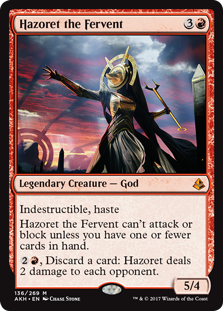 Over Snapcaster Mage, KYLEHL includes a peculiar bullet for Traverse the Ulvenwald: Hazoret the Fervent. Over the last year, I've become totally enamored with Hazoret in this kind of list. The God is excellent at closing out games, sniping planeswalkers, and providing resilience and even a free-win dimension against many interactive decks; everyone not on white or Dismember simply cannot remove her, allowing Hazoret to completely change the texture of many matchups after resolving. Maining her initially struck me as odd, as KYLEHL only plays 16 lands. But Traverse and Bauble help get to them, and Hazoret can always be pitched to Looting in matchups that don't call for a 5/4 haste.
Over Snapcaster Mage, KYLEHL includes a peculiar bullet for Traverse the Ulvenwald: Hazoret the Fervent. Over the last year, I've become totally enamored with Hazoret in this kind of list. The God is excellent at closing out games, sniping planeswalkers, and providing resilience and even a free-win dimension against many interactive decks; everyone not on white or Dismember simply cannot remove her, allowing Hazoret to completely change the texture of many matchups after resolving. Maining her initially struck me as odd, as KYLEHL only plays 16 lands. But Traverse and Bauble help get to them, and Hazoret can always be pitched to Looting in matchups that don't call for a 5/4 haste.
Other Bullets
Hazoret isn't the only eyebrow-raising one-of in the mainboard. Another is Abrade, a standard tech in URx interactive decks, but a strange choice for a deck with such a low curve. I imagine KYLEHL didn't want to lose to any random artifacts in game 1, and decided to do something about it.
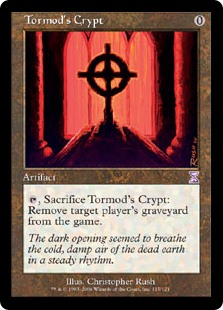 Same deal with Dredge, and a couple of sideboard cards make the cut here: Anger of the Gods and Tormod's Crypt. Anger doesn't just deal with Dredge, but with any wide board Temur is otherwise hard-pressed to beat. Without Snapcaster Mage in the picture, reach is harder to come by in the mid-game, and Anger can punch through a board for a final strike.
Same deal with Dredge, and a couple of sideboard cards make the cut here: Anger of the Gods and Tormod's Crypt. Anger doesn't just deal with Dredge, but with any wide board Temur is otherwise hard-pressed to beat. Without Snapcaster Mage in the picture, reach is harder to come by in the mid-game, and Anger can punch through a board for a final strike.
Crypt was tougher for me to wrap my head around. It's good enough against Dredge that we're starting to see Burn, Arclight, and other aggressive decks play a few in the side. But does it do anything elsewhere? As its floor, Crypt helps Mandrills or Traverse get going, as well as pump Goyf free-of-charge. So does Bauble, but KYLEHL already maxes out on those. And I imagine Crypt has plenty of edge-case applications against existing Modern decks besides Dredge: exiling a Snapcaster target, say, or taking Grixis off its Gurmag Anglers for a turn or two. Arclight Phoenix's recent explosion onto the scene is another factor to weigh.
In these roles, Crypt is definitely worse than Surgical Extraction, as opponents learn about it before it activates. But perhaps its synergistic elements make up the difference. I'd be interested in hearing what the pilot has to say about the card.
Sideboard
Speaking of speaking of bullets, check out this sideboard! I'll admit that I have little-to-no idea about what's holistically going on here, but I do have a few random observations:
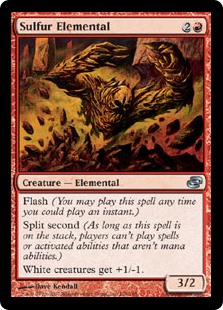 Ravenous Trap and Grafdigger's Cage come in as additional Dredge hate
Ravenous Trap and Grafdigger's Cage come in as additional Dredge hate- Alpine Moon, Blood Moon, Ceremonious Rejection, and Disdainful Stroke help against Tron
- Natural State, Ancient Grudge, and Back to Nature make up the artifact/enchantment removal suite
- Flame Slash and Entrancing Melody answer large creatures, with the latter helping specifically against Goyf and Shadow (as Explosives does for Temur Midrange)
- Pithing Needle and Spell Pierce have applications against combo and control
- Sulfur Elemental can be found by Traverse and answers Lingering Souls tokens, certain Humans boards, and the pesky Martyr-Proc deck we've seen so much of online lately
- Life Goes On hoses Burn
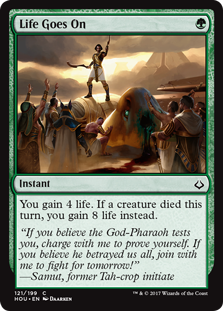 It seems KYLEHL's choices were made largely with the intent of giving the pilot lots of choice and flexibility while sideboarding. Many of these cards play multiple roles, with Life Goes On being the big exception; I wouldn't be surprised if after many matches of tuning, KYLEHL landed on this sideboard configuration organically, as opposed to via having lost a bet.
It seems KYLEHL's choices were made largely with the intent of giving the pilot lots of choice and flexibility while sideboarding. Many of these cards play multiple roles, with Life Goes On being the big exception; I wouldn't be surprised if after many matches of tuning, KYLEHL landed on this sideboard configuration organically, as opposed to via having lost a bet.
Spell-Slinging and Taking Names
Are Temur decks finally ready to emerge as a solid Tier 2 option in Modern? Or were these three pilots just lucky? Share your thoughts in the comments, and join me Friday for a look at cool-little-brother Jeskai's new offerings.





My personal favorite is the third deck, the delver one. I think it looks like as close we can get to legacy thresh in Modern. The weird silver bullet cards like tormod’s crypt and abrade seem like ways to make up for the lack of strong countermagic, IE force of will or daze, that we have in modern.
Check out the links in the above article, or my article archive (esp. the “Monkey Grow” tag), for plenty more content on this style of Temur Delver deck!
https://quietspeculation.com/tag/monkey-grow/